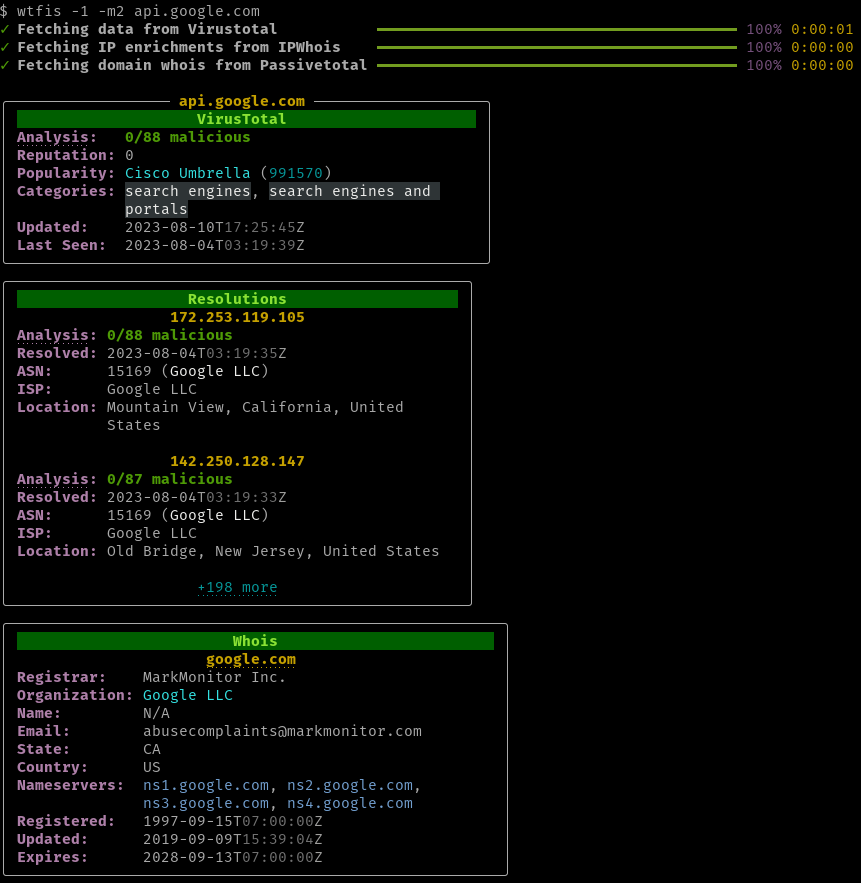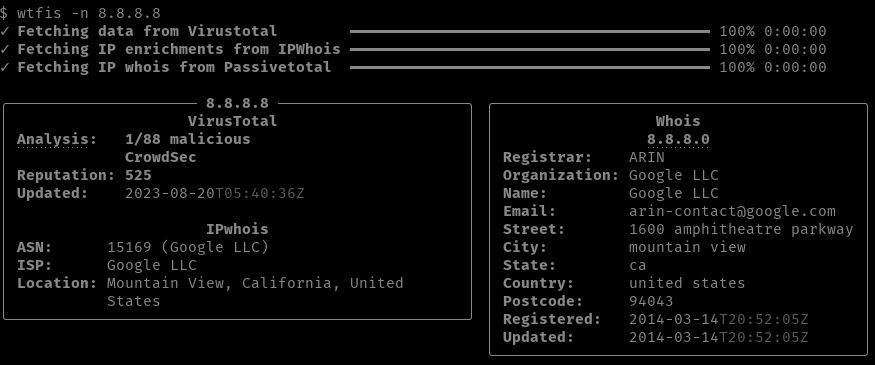Passive host and domain name lookup tool for human eyes
Project description
wtfis
Passive host and domain name lookup tool for non-robots
WTF is it?
wtfis is a commandline tool that gathers information about a domain or FQDN using various OSINT services. Unlike other tools of its kind, it's built specifically for human consumption, providing results that are pretty (YMMV) and easy to read and understand.
This tool assumes that you are using free tier / community level accounts, and so makes as few API calls as possible to minimize hitting quotas and rate limits.
The project name is a play on "whois".
Data Sources
Virustotal
The primary source of information. Retrieves:
- Hostname (FQDN) or domain
- Latest analysis stats with vendor detail
- Reputation score (based on VT community votes)
- Popularity ranks (Alexa, Cisco Umbrella, etc.)
- Last DNS record update date
- Date DNS record was last retrieved by VT
- Resolutions
- Last n IP addresses (default: 3, max: 10)
- Latest analysis stats of each IP above
- Whois
- Fallback only: if Passivetotal creds are not available
- Various whois data about the domain itself
Passivetotal (RiskIQ)
Optionally used if creds are provided. Retrieves:
- Whois
- Various whois data about the domain itself
IPWhois (ipwhois.io)
IP address enrichments for VT resolutions. For each IP, retrieves the ASN, Org, ISP and Geolcoation.
Install
$ pip install wtfis
Setup
wtfis uses these environment variables:
VT_API_KEY(required) - Virustotal API keyPT_API_KEY(optional) - Passivetotal API keyPT_API_USER(optional) - Passivetotal API user
Set these using your own method.
Alternatively, create a file in your home directory ~/.env.wtfis with the above declarations. See .env.wtfis.example for a template. NOTE: Don't forget to chmod 400 the file!
Usage
Basically:
$ wtfis FQDN_OR_DOMAIN
and you will get results organized by panel, similar to the image above.
If your terminal supports it, FQDN, domain, and IP headings are clickable hyperlinks that point to the appropriate pages on the VT or PT (RiskIQ) website.
You can increase or decrease the maximum number of displayed IP resolutions with -m NUMBER or --max-resolutions=NUMBER. The upper limit is 10. If you don't need resolutions at all, set the number to 0.
To show all panels in one column, use the -1 or --one-column flag.
Panels can be displayed with no color with -n or --no-color.
Finally, there's a help flag (-h or --help) if you need it.
TODOs
- JSON output
- Shodan integration
- IP address lookup
- Keyring support
Project details
Release history Release notifications | RSS feed
Download files
Download the file for your platform. If you're not sure which to choose, learn more about installing packages.














